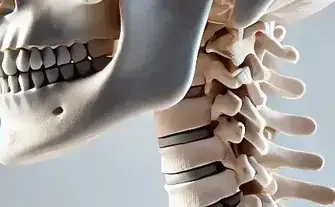Woke up and can’t move your neck? You’re not alone. Every year, more than 10 million Americans experience sudden neck stiffness that can feel like your head is glued in place. It might strike after a night of bad sleep, a long drive, or even a stressful week at work. The pain can range from a mild ache to a sharp, immobilizing spasm. But while it can be alarming, in most cases, it isn’t dangerous.
Can’t Move Neck to the Left or Right — What’s Happening?
When you can’t turn your head to one side, a muscle spasm or pinched nerve is the usual suspect. Sleeping awkwardly or working long hours at a desk can trigger spasms in the levator scapulae or trapezius. A herniated disc may also compress the cervical nerve roots.
Case Example: A 41-year-old woman from Dallas woke up unable to turn her head left after a long car ride. Imaging showed a mild muscle strain; symptoms resolved after four days of rest, heat therapy, and gentle stretching.
| Common Causes of Directional Neck Stiffness | Duration | Treatability |
|---|---|---|
| Muscle spasm | 3–7 days | Excellent |
| Pinched nerve | 1–4 weeks | Good |
| Herniated disc | 2–6 months | Moderate |
| Arthritis | Chronic | Fair |
This pattern is consistent with clinical data from major spine health sources ⧉.
Understanding the Main Causes Behind Neck Immobility
Neck stiffness stems from several key causes, each with its own set of triggers and typical patient profile.
- Muscle strain or spasm: The most common cause — usually from sleeping awkwardly, sudden jerky movement, or spending long hours hunched over a phone or laptop. This kind of strain can cause sharp pain and limited motion but typically eases within a few days with rest and gentle stretching.
- Pinched nerve: When a nerve exiting the spine becomes compressed — often due to poor posture, disc changes, or even carrying a heavy shoulder bag. It may cause pain that radiates down the shoulder or arm, often accompanied by tingling. People who drive or work at computers for hours are especially prone.
- Herniated or bulging disc: A more advanced issue where the soft center of a disc pushes out and presses on nerves. This can develop after heavy lifting or gradual wear over time. Pain may flare when turning or bending the neck and sometimes radiates down the arm. It’s less common but slower to heal, sometimes requiring imaging and guided therapy.
- Osteoarthritis (degenerative disc disease): Over years, the spinal discs lose hydration and elasticity, leading to stiffness and grinding sensations. Common in adults over 50, it may make mornings especially uncomfortable but often improves throughout the day. While chronic, proper ergonomics and muscle conditioning help control symptoms.
- Spinal stenosis: A rarer but serious cause, in which the spinal canal narrows and compresses the nerves or spinal cord. It’s usually age-related and may lead to weakness, numbness, or coordination problems if untreated. Early evaluation is vital to prevent progression.
Among these, muscle strain and posture-related tension account for about 70% of neck stiffness cases in adults. Meanwhile, structural issues such as herniated discs or spinal stenosis are less common but often more persistent and require professional supervision ⧉.
How Doctors Diagnose a “Locked” Neck
Modern diagnostics provide detailed insights into what’s causing your neck pain and stiffness. Each method offers specific advantages depending on symptoms and severity.
X-ray
A simple and quick imaging test that shows bones and joint alignment. It helps detect fractures, bone spurs, or joint degeneration. The process takes about 10–15 minutes, and results are usually ready the same day. Accuracy: 6/10; Cost: ~$100 (€90).
MRI / AI-Assisted MRI
MRI uses magnetic fields and radio waves to produce detailed images of soft tissues, discs, and nerves. When enhanced with AI analysis, it can highlight subtle inflammation or nerve compression automatically, reducing diagnostic errors. The scan takes about 30–45 minutes, and results are typically available within 24 hours. Accuracy: 9/10; Cost: ~$400–800 (€370–740).
Dynamic Ultrasound
This imaging method uses sound waves to view muscles and ligaments in motion, allowing doctors to see how tissues behave when you move your neck. It’s noninvasive, quick (10–20 minutes), and ideal for detecting muscle tears or inflammation. Accuracy: 8/10; Cost: ~$150 (€140).
Digital Posture Analysis (Wearable Sensors)
Small, smart sensors track how your head and shoulders align during daily activities. The data is analyzed to detect posture-related neck strain. It’s painless and can be done at home or in a clinic with immediate results through an app. Accuracy: 7/10; Cost: ~$75 (€70).
Doctors often combine two or more of these methods to build a complete picture — for instance, pairing MRI with posture analysis to differentiate between muscle and nerve issues. Cleveland Clinic experts confirm this combined approach improves diagnostic precision ⧉.
What Helps When You Can’t Turn Your Head?
Q: What can I do at home?
A: Rest briefly, then move gently. Use ice for the first 48 hours (20 minutes at a time), followed by moist heat or a warm shower. Over-the-counter NSAIDs like ibuprofen or naproxen can ease pain and swelling.
Reyus Mammadli, medical consultant, recommends keeping daily neck mobility even during discomfort: “Move, but don’t push through sharp pain — the goal is gentle motion, not a hero moment.” This aligns with Healthline’s home care guidance ⧉.
If pain worsens or persists beyond a week, consult your doctor. Severe pain, weakness, or numbness should never be ignored.
Modern Treatments That Actually Work
Modern medicine provides several advanced approaches for those who can’t move their neck due to pain or stiffness. Here’s a deeper look at each.
TENS Therapy (Transcutaneous Electrical Nerve Stimulation)
TENS therapy uses a small battery-operated device that sends mild electrical pulses through electrodes placed on the skin. The gentle current interferes with pain signals sent to the brain and stimulates the release of endorphins, the body’s natural painkillers. A session typically lasts 15–30 minutes and is painless — most patients feel a light tingling sensation. Effectiveness: 8/10; Cost: ~$50 (€45).
Think of it like rebooting a computer: the electrical stimulation “resets” the pain signals, giving your neck a chance to relax and recover.
Laser Therapy
Laser therapy, or low-level light therapy, delivers concentrated light energy deep into soft tissues. The process boosts cellular repair, reduces inflammation, and promotes faster healing in strained muscles or irritated nerves. Sessions last about 10–20 minutes and are performed by physical therapists or pain specialists. Effectiveness: 7/10; Cost: ~$100 (€90).
It’s like sending a “light massage” directly into your sore neck muscles — no heat, no pain, just healing stimulation.
Dry Needling
Dry needling involves inserting thin, sterile needles into tight muscle bands, known as trigger points. This triggers a reflex that relaxes the muscle and increases blood flow to the area. The procedure takes about 15 minutes and may cause mild soreness afterward, similar to post-workout stiffness. Effectiveness: 6/10; Cost: ~$120 (€110).
Many patients describe it as “turning off” the muscle knot that’s been causing their stiffness. Unlike acupuncture, dry needling targets specific muscles responsible for pain rather than energy meridians.
AI Posture-Training Devices
These wearable sensors monitor your posture in real time, sending gentle vibration alerts when you slouch or tilt your head forward. Over time, this builds better muscle memory and helps prevent chronic neck strain. The setup is simple — most devices connect to a mobile app that tracks progress and provides guided exercises. Effectiveness: 8/10; Cost: ~$150 (€140).
According to Reyus Mammadli, combining posture-training devices with traditional therapy can reduce recurrence rates by up to 40% in chronic cases.
Recovery and Prevention
Most people recover from neck stiffness within 1–2 weeks, but true healing involves changing habits. Here’s how to make sure your neck stays healthy and mobile long term.
Lift Properly
Always bend at the knees, not the waist. Keep your back straight and the object close to your body. When lifting something light like a laptop bag or grocery bag, avoid twisting your upper body — pivot your feet instead. If lifting causes any pulling or discomfort in your neck or shoulders, stop immediately and reposition your stance.
Maintain Posture
Your ears should align directly above your shoulders — that’s a simple way to check if your posture is neutral. When sitting, keep your back supported and shoulders relaxed. Avoid leaning your head forward toward screens. A good tip: every 20 minutes, gently draw your head back as if making a double chin — it realigns your cervical spine naturally.
Take Micro-Breaks
Micro-breaks mean 30–60 seconds of movement every 30–40 minutes. Stand up, roll your shoulders, and stretch your neck gently side to side. The goal isn’t exercise but circulation — keeping blood flowing to muscles that stiffen from stillness. If your neck feels warm and relaxed after, you’re doing it right.
Sleep Ergonomically
Choose a pillow that supports the natural curve of your neck — neither too high nor too flat. Back sleepers often do best with a contoured memory-foam pillow, while side sleepers may prefer a medium-firm one that keeps the head level with the spine. Replace old pillows every 1–2 years; even the best lose their support with time.
Stay Hydrated
Intervertebral discs — the cushions between your vertebrae — are mostly water. Dehydration can reduce their flexibility, leading to stiffness. Aim for about 2 liters (8 cups) of water per day, more if you’re active. Signs you’re hydrated: light-colored urine, steady energy, and fewer muscle cramps.
These steps help keep your neck flexible and resilient. They may seem small, but consistency turns them into long-term protection against pain and stiffness ⧉.
Editorial Advice
Reyus Mammadli, medical consultant, reminds: “Your neck is like a precision instrument — it needs alignment and care, not force.” He suggests daily mobility exercises and a quick posture check every two hours during screen work. If you wake up stiff, use mild heat and slow head turns instead of aggressive stretching.
Keep your workstation ergonomic, your pillow supportive, and your attitude flexible. After all, your neck isn’t just there to hold your head — treat it like the MVP of your posture team.









During a camping trip months ago, I had a very severe case of stiff neck when I woke up in my tent. Even though it disappeared after a day or so, the pain was still significant that I don’t want it to ever happen again. It’s interesting to know that steroids can be used to treat some neck pain but I think I’ll just stick to getting prescriptions for muscle relaxants.